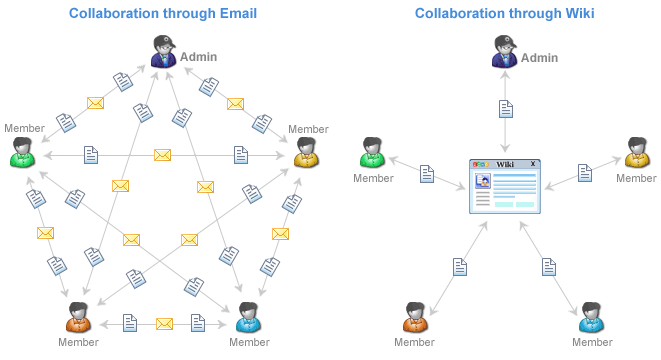Course talk:ETEC522/2010ST1/CollaborationTechnologies/leadinglearningapplications
History of Online Collaboration and its Evolution into Google Docs and Google Sites
Brief History
Collaboration platforms started with the military and universities (ARPANET). Online discussion groups and the ability to complete group work began with platforms developed in the 1970's. However, these tools were not readily available to the consumer. Online discussion/realtime communication became popular in the 1990's with programs such as ICQ. These realtime communication tools have evolved over the years with MSN Messanger being one of the front runners.
In the early part of the new century peer to peer tools began to expand enabling users to share files with each other. Kazaa and Napster are two of the more common iterations of this software type. Kazaa's developers worked out a software solution that permitted the sharing of realtime video files in 2003, ebay then acquired what we know as Skype in 2005.
Where is online collaboration going?
Recently, the past three to four years, the evolution of these communication and sharing tools has taken place, even more so with the devlopment of SmartPhones to the point that companies such as Zoho and Google have decided to group these tools into one package or "suite". With poeple on the move, global markets opeing up and "just not enough time in the day", these tools are enabling consumers to interact, develop, plan and create (collaborate) in one place - The "Cloud".
Applications that are being developed for collaborative purposes include the ability to develop documents and presentations in realtime with group members (Google Docs), the ability to plan and brainstorm (Google Wave) as well as create an online collaborative presence where ideas can be shared and lessons learned (Google Sites). Of course if an immediate chat is required, it can be done the old fashion way by typing or via video (Google Talk).
Applications of online collaborative tools
These suites of online applications are pertinent to many areas: informal, k-12, post-secondary, adult education and to the corporate business world. Applications save time and money primarily. This enables projects, assignments or sales to occur quickly and efficiently. They reduce the software that individuals used to purchase in the past and install themselves on their computer. Applications permit the timely sharing of information, which overall should result in an improved final individual or group project.
Tools such as the Google Wave are taking the online suites of application and compacting them even further. Groups can share ideas, edit documents, insert other gadgets and productivity widgets to collect and share data within a group, etc. Question: could applications such as Google Wave became the ultimate all-in-one SuperTool?
http://wiki.zoho.com/Share-and-Collaborate.html, accessed June 12, 2010
Potential impact of online collaborative tools in the a K-12 environment
When considering the K-12 educational environment the question arises: what will be the impact of suites of online applications such Google Apps, with regards to to a K-12 classroom?
Students can plan projects via discussion and sharing of ideas in Google Wave. Teachers can sit in on the sharing as it occurs and can provide guidance. By asking the students to use this tool outside of class time (homework) a teacher can make better use of class time for activities or the creation of projects, lab activities etc. E.g. Science 10 in BC is a difficult course to find time for labs, activities and extented investigation of topics (topics) or preparing for exams. By using a tool such as Google Wave outside of class time in the classroom is spent doing and not planning.
Students can work on a collaborative document or presentation. They do not loose any information by forgeting to save a document. Students can have a teacher review and edit material in realtime to ensure the group is on track. The teacher does not have to wait for an e-mail or worry that their inbox has no more memory available, as the students documents are stored online.
Students can also develop learning resources for themselves by creating an online presence via a wiki space or in this case Google Sites. Students can collect resources, develop ideas for learning topics and ask questions, which can be shared amongst themselves. Teachers can review the material and answer questions by posting and inserting relevant information, which the entire class then benefit from.
To provide evidence of the usefulness of these Google Apps a Google Site has been created. Within this site you will be able to collobarate on the topic of Earthquakes and Volcanoes. This topic has been the focus of many news cast in the past year as well as a key curricular area in the BC Science 10 curriculum. By collaborating we can share knowledge, fix any misconceptions and discuss any personal experiences.
Google video for the promotion of the use of their apps in education: http://www.youtube.com/watch?v=IRYRbPCHTck
From connectingeducation.com: http://www.youtube.com/watch?v=qmiaguECzd0
Student Perspective: http://www.youtube.com/watch?v=miYvAh09M_M&feature=related
Google Apps Tour: http://www.youtube.com/watch?v=kJT3pagjd8s&feature=related
Google Apps, a business perspective: http://www.youtube.com/watch?v=Pqe2eCtY4Pg&feature=channel
Google Sites Vid: http://www.youtube.com/watch?v=X_KnC2EIS5w&feature=channel
Just to throw another contender into the mix: http://lifehacker.com/315256/zoho-suite-vs-google-docs#poll_=MDN5MTM
- [View source↑]
- [History↑]
